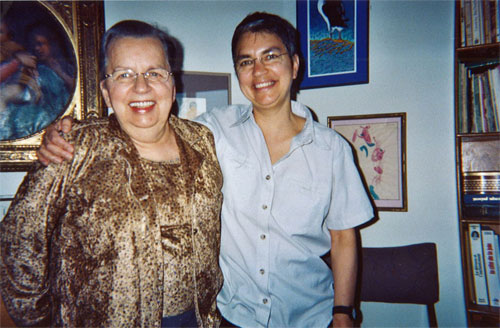Pauline Gagnon
23 February 2011 | By

When exactly did her interest in science start, Pauline Gagnon cannot say. "I always wanted to know what matter was made of,” she explains. Inspired by Marie Curie, her first choice was chemistry. No wonder that nine-year-old Pauline's dearest wish for Christmas was a chemistry kit. Unfortunately it said "Recommended for ages 10 and older" on the box. So her parents opted for a microscope instead and she had to wait another year to start chemistry experiments. "The best experiment was the one producing rotten egg smell - the whole family could tell it had been successful,” she recalls. She kept the mortar and pestle from that chemistry kit and uses it today to ground spices.
That summer, her aunt told her about a new television show called: ‘Atoms and Galaxies’ due to start the following September. She thought these would be the main characters in a new adventure series so waited with anticipation. What a disappointment to find a rather boring man in a lab coat talking about absolutely incomprehensible stuff, as was common in the sixties. So she gave up after only one show.
In high school, her sister could not quite understand why Pauline was so attracted by chemistry “Why chemistry, at least physics is interesting!” Since she was one year older, she ought to know.
Pauline started studying physics without a clue what she could do with it and lacking support in general, although her mother had always encouraged her daughters to study, having herself gotten her degree after raising her five kids. “But it was very typical for French Canadians at that time not to set their hopes too high,” Pauline explains. “Being a minority, French Canadians had less of a future. So none of my professors ever encouraged me to go any further than a bachelor degree.”
She started writing for a science magazine to pay for her studies. “There was never a summer job for me so I created my own as a science writer.” She finished her education with a bachelor in physics and taught in a college for the following six years. She would have stayed, but life had other plans: “I fell in love, quit my job and drove 7000 km to move to California,” Pauline remembers. There, her friend suggested a visit to SLAC. Being very impressed and once again having to support herself, she decided to write an article about it. She phoned SLAC press office and made an appointment. “Here I was with my small tape-recorder - a total unknown, writing for an unknown magazine in Quebec. I could barely speak English and barely knew about quarks and gluons. And who did they line me up with but Martin Perl, who got the Nobel prize ten years later, Jonathan Dorfan, who became SLAC director and Helen Quinn, one of their most prestigious theorist!”
This was the main inspiration for going back to school. California also provided a very supportive climate for re-entry students. “One never knows where falling in love might lead you to!” So Pauline applied for a master in physics at San Francisco State University. “When I came to register, the department chair noticed I had taught in a college for many years. As they were short of a lecturer, he hired me on the spot. Teaching in English was very tough for me though as I always read the equations in French, even in English textbooks. Luckily there was always a kind student to read the equations aloud for me and slowly I learned the terms,” Pauline recalls. “While taking a quantum mechanics class, I paid more attention to how the professor read the equations than to the lecture.”
After completing her PhD in Santa Cruz, Pauline eventually came to CERN with her partner to work on the OPAL experiment and joined the Indiana University group in 1999. “I came for a year - 16 years ago.” About five years ago, Peter Jenni asked her to be ATLAS e-News editor. "That was a great opportunity! When I took over, there were four issues a year but so much was happening, I proposed to do one issue a month. Soon, Ceri Perkins, Colin Barras and Christina Jimenez came on board, and we started covering every aspects, including social events and outreach issues. There is so much information in ATLAS, the goal is to give an ‘ executive summary’ - a kind of snapshot of what is happening.”
Over the last four years, Pauline split her time between research, ATLAS e-News and outreach. “I always enjoyed communication as a teacher, giving lectures to the general public, being an ATLAS guide or talking with journalists. Doing outreach keeps me in contact with reality.”
It was her idea to mark International Women's Day on 8 March 2010 at CERN, also followed by Fermilab. By showing how many women are working on the LHC, Pauline hopes to send an encouraging message to young women interested in science. In 2009, she suggested to a group of ATLAS women to join the ‘Expand your horizon’ program in Geneva, where women scientists led hands-on workshops for young girls to inspire scientific careers.
To balance the long hours in front of her computer, Pauline loves all kinds of outdoor sports: running, biking, hiking and skiing - everything that can be done outside no matter the weather conditions. She participated in several runs, the longest being the Geneva marathon in 4:38 hours, and the strangest, a half marathon ending at 1:00 am in Tromso, Norway under pouring rain and not the advertised midnight sun!
Last December, Pauline decided to step down as ATLAS e-News editor: "It's time to give someone else the chance to bring their own new ideas," she says as she now plans to spend more time on her other interests.



